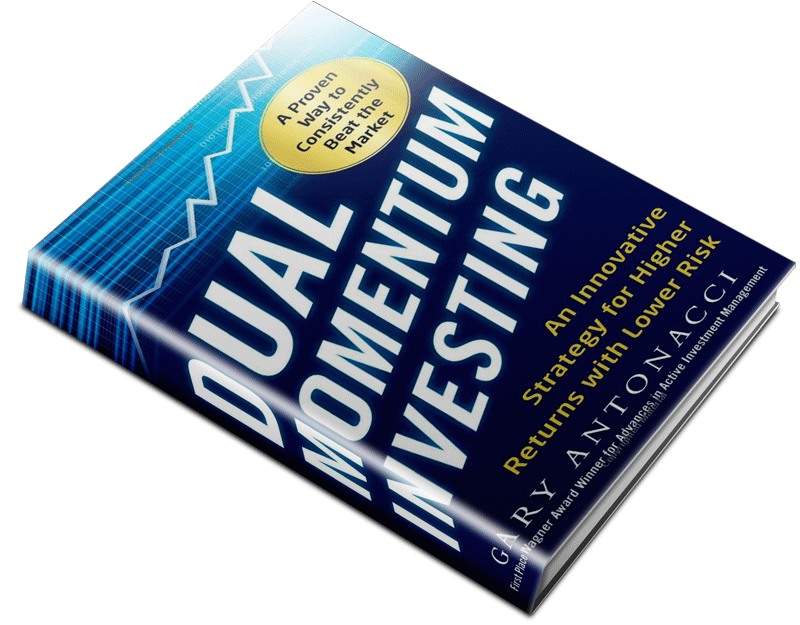by Ben Carlson, A Wealth of Common Sense
In my previous post I took a look at why the momentum factor has worked historically in the markets. The past numbers are impressive, but there are some drawbacks, including high turnover, tax inefficiency, large drawdowns and high costs associated with momentum strategies. It’s also a fairly counter-intuitive approach to get comfortable with. Dual Momentum, a book by Gary Antonacci, looks to minimize these problems.
I get a number of reader requests for writing ideas on this site, but by far the most requested topic has been for my take on this book and the strategy Antonacci lays out. The book explains in detail the difference between the two types of momentum-based investing:
Relative Momentum: Also known as relative strength, this form of momentum compares the trend of an investment to another investment in order to choose which asset class or securities to invest in. You choose the asset or group of securities that have been outperforming on a relative basis in the hope that the outperformance will continue. In the book, U.S. stocks are compared with international stocks on a relative basis.
Absolute Momentum: This is when an asset’s trend is compared to its own performance. For example, Antonacci compares the excess of stock returns over cash returns over a 12 month period to determine if the absolute momentum is positive or negative.
Antonacci combines to two approaches into a single system, hence the term dual momentum. The results in the book are quite impressive, with higher returns, lower volatility and lower drawdowns than the overall stock market.
Here’s what I like about the strategy:
1. It’s simple. The system requires just three funds or ETFs to pull off — an S&P 500 fund, a total international stock index fund and a total bond market index fund. This makes the underlying investments both simple and cost-effective.
2. It’s rules-based. There’s no discretionary decisions required. The relative momentum rule requires a comparison of the past 12 month returns for U.S. versus international stocks. The absolute momentum rule compares the higher trending of these two stock markets to the past 12 month returns for t-bills. If the S&P 500 has a higher return than both international stocks and cash, you hold the S&P. If international stocks have a higher return than the S&P and cash, you hold international stocks. If cash has a higher return than stocks, you hold the bond fund.
3. It’s a low activity strategy. The rules are only checked once a month for rebalancing purposes, which leads to a fairly low turnover compared to other momentum strategies. According to the book, going back to 1974, the strategy only made an average of 1.35 changes per year.
4. It’s based on both historical evidence and investor behavior. I ran the numbers for this strategy myself and they are quite impressive. The back-test makes sense as do the behavioral reasons for the momentum factor. All good investment strategies are based on taking advantage of other investor’s mistakes and behavioral biases and this one is no different on that front.
Now for some drawbacks and caveats:
1. It’s a concentrated strategy. You’re only in one asset class at a time based on the signals of the model. Here’s the breakdown since 1974: 41% of the time in U.S. stocks, 29% of the time in international stocks and 30% of the time in bonds. This strategy is diversified across market cycles more than across asset classes in the more traditional sense.
2. The psychology of going all-in or all-out. Dual momentum is a simple strategy, but no position in the markets is ever easy. It can be very difficult to psychologically go from an all stock to an all bond position. Some investors simple cannot stomach following market timing signals, no matter how simple they may be.
3. There’s nothing special about absolute or relative momentum. These aren’t magical indicators. You could always make tweaks and changes to data-mine better results and it’s quite possible momentum won’t work nearly as well going forward as it has in the past. That’s always a risk of any strategy.
4. It’s not always going to work. Nothing works all the time. Since 2009 this strategy has underperformed the S&P 500 by wide margin. But if you go back to 2008, dual momentum has actually done better than the S&P, because the strategy is built to perform better during bear markets. It works best during large drawdowns, but nothing can save you from all losses. Trend following rules are never going to get out right at the top, nor get in right at the bottom. There’s also the potential for whipsaw of false signals that reverse course in short order. There are always going to be trade-offs.
5. Back-tests only tell you what has happened, not what will happen. This is true of all investment strategies, but it’s worth remembering that the future is promised to no one in the markets.
The verdict? You have to know yourself as an investor when considering this type of strategy. It’s more about knowing yourself than understanding the strategy. Here are some questions to think about in terms of dual momentum:
- Momentum may continue to work, but will it work for you personally?
- Do you understand this type of system enough to force yourself to follow it?
- Will this type of strategy allow you to make fewer emotionally charged decisions during market losses?
- Would adding a trend following rule reduce or accentuate your behavioral biases?
- Would it make you more or less emotional about your portfolio decisions?
It’s almost impossible to recommend this or any system to an investor without first understanding where they’re coming from. Even simple strategies are never easy. This system has worked in the past, but investors have to define what “works” means to them. I say an investment strategy “works” if you’re to follow it over many different cycles. It never “works” if you bail out at the first sign of trouble or relative underperformance.
Even if you’re not interested in the Dual Momentum model, I think the book is worth a read because it covers nearly every other strategy you can think of and cites the pros and cons of each along with a long list of research. The sheer number of research papers cited and explained in the book alone makes it worth the price of admission.
As always, read the book and do your own homework before considering this or any type of investment strategy:
Dual Momentum: An Innovative Strategy for Higher Returns and Lower Risk
Also check out Gary’s website for more on the topic:
Dual Momentum
Further Reading:
Why Momentum Investing Works
The Psychology of Sitting in Cash
Subscribe to receive email updates and my quarterly newsletter by clicking here.
Follow me on Twitter: @awealthofcs
My new book, A Wealth of Common Sense: Why Simplicity Trumps Complexity in Any Investment Plan, is out now.
Copyright © A Wealth of Common Sense














